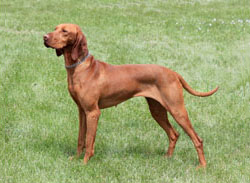Vizslas are medium-sized dogs with an attractive, golden-rust coat that is short, close lying, smooth, and dense. Lighter shadings may be present over the sides of the shoulders and neck that give a saddle-like appearance. The ears are silky, thin, and proportionately long, and the eyes are medium in size. Vizslas measure 21 to 24 inches tall at the shoulder and weigh 50 to 65 pounds.
They bond deeply with their human family members, adapt easily to new situations, and get along with just about everyone, including other pets.
In need of a lot of exercise and craving outdoor activity, the Vizsla is best suited for active families. These lively, loving, and intelligent dogs take well to training, are generally low-maintenance, and get along well with most people, including children. These dogs become very attached and devoted to their human families.
Vizslas mature early and can point and retrieve with superior ability before their first birthday.
Affectionate, lively, and gentle, the Vizsla is a great choice for families with children seeking a loving and energetic companion animal. These dogs are sensitive and protective, without ever being timid or aggressive. They bond deeply with their human family members, adapt easily to new situations, and get along with just about everyone, including other pets. They do not make good watchdogs.
There will always be a bit of tomfoolery in any home where a Vizsla lives. These dogs are quirky and mischievous and tend to get into trouble. Stealing food, digging holes, and chewing shoes are some of the breed's favorite activities that likely won't please humans in the house. Giving these dogs the attention and affection they crave and need will help.
Adequate exercise is also important, and these dogs need daily, strenuous activity to keep them from becoming bored, destructive, and unhappy. Jogging, running around in a securely fenced yard, and hiking are good choices for this breed. Taking the Vizsla along on bike rides and runs is a good way to satisfy activity and attention needs at the same time.
Vizslas are known to suffer from a variety of health problems, some of which can negatively affect quality or length of life. Adopting or purchasing one of these dogs from a reputable source who is willing to supply detailed family and health records goes a long way toward ensuring a healthy adult dog.
Health problems seen in the breed include epilepsy, hip dysplasia, craniomandibular osteopathy, hypothyroidism, skin allergies, and blood clotting disorders, such as von Willebrand's disease and hemophilia. Vizslas are also prone to certain eye conditions, including cataracts, entropion, and progressive retinal atrophy. Some cancers, such as lymphosarcoma and hemangiosarcoma, are also more common in these dogs than in some other breeds.
Vizslas typically live 10 to 14 years, provided they receive routine veterinary care, timely vaccinations, proper nutrition, and daily exercise.
Vizslas are excitable dogs that need training from an early age. Fortunately, these dogs are highly trainable; without firm, consistent training, the breed can be difficult to manage and develop numerous inappropriate behaviors. Digging can be a problem, and untrained Vizslas are prone to mouthing and biting small children and other pets.
Praise, treats, and play rewards are very motivating, and positive reinforcement techniques generally provide a much higher rate of success than other training methods. These dogs need affection and fear being separated from their family, and they may shut down or regress if harshly criticized or yelled at.
Early socialization helps prevent these dogs from growing into suspicious, timid, or nervous adults. They need to learn the difference between real and imagined threats. Puppy kindergarten, walks around town on a leash, visits to local businesses, and time playing at the dog park will boost the breed's confidence and tolerance.
Easy to groom, the Vizsla needs only occasional brushing to maintain its glossy coat. Brushing once or twice weekly will distribute skin oils throughout the coat and remove dead hair to reduce shedding. A rubber curry brush or firm bristle brush are good choices for this breed's coat; both will improve the health and appearance of the hair.
Baths are rarely necessary; every two to three months is plenty, unless the breed rolls around in something toxic, stinky, or sticky. It's important to use a pH-balanced shampoo designed for use on dogs when washing the coat. Products made for humans are too harsh and irritating. A thorough rinsing will remove traces of soap to prevent dry skin.
The nails need clipping every week or two to prevent snags, breaks, and clicking against the floor. Daily brushing will keep bad breath at bay while helping to prevent cavities and potentially serious gum disease. Additionally, weekly ear examinations should be performed to look for accumulated ear wax and signs of ear infection, such as redness, odor, discharge, and swelling.
Vizslas descended from ancient hunting and companion dogs that belonged to Magyar hordes that settled in Hungary hundreds of years ago. Early barons prized the dogs, and their likeness is depicted in etchings dating back to the 10th century. Vizslas were quick and careful and had a superior sense of smell, which made them perfect for hunting agricultural lands in Hungary.
The breed was very popular, but by the end of the 19th century, its numbers had declined. After a dozen quality specimens were discovered, efforts to revive the breed started and were successful. During World War I, Vizslas worked as messenger dogs, and the war weakened their numbers once again. World War II then spread the dogs throughout the world. They made their way to the United States, where they quickly became popular.
Today, the breed is seen in the show ring and field. Vizslas are also popular companion animals. Additionally, some work as guide dogs, search and rescue dogs, and drug-detection canines. Crossbreeding with the German Shorthaired Pointer and Weimaraner in recent years has created the wiry Vizsla we know today.
The American Kennel Club officially recognized the Vizsla in 1960.

